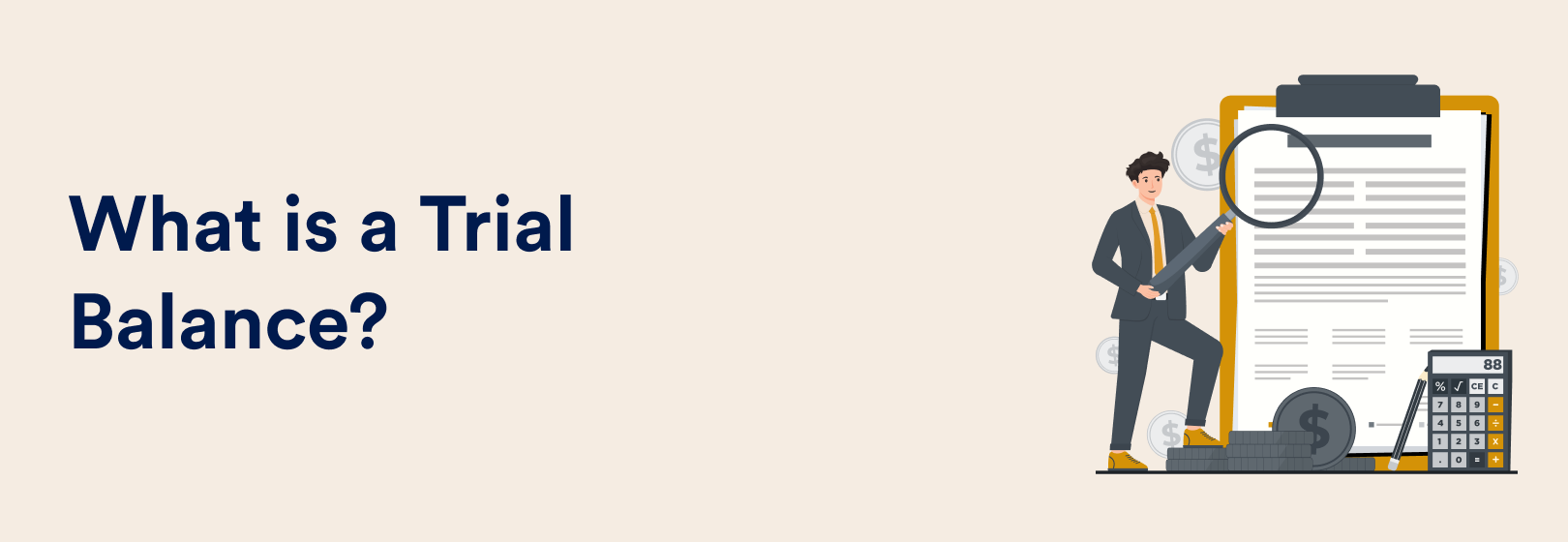There’s no two ways about it: when it comes to accounting, precision is key. Your business is required to maintain accurate financial records, and it makes sense to do so if you want to make sound decisions, be in the good graces of the IRS, and be able to produce reliable reports. An important tool to ensure the accuracy of bookkeeping is the Accounting Trial Balance. But what is a trial balance, why does it matter, and how does it work?
In this article, we are going to discuss the Trial Balance Definition, Importance, Examples, and Format, with examples in real life. Identity of an Account (Worksheet), whether you are a student, a small business owner, or new to acting as your accountant, we have you covered. This guide gives you the easiest way to understand your topic, at your own pace. A trial balance is nothing but a list of all the ledger account balances.
Trial Balance Definition
A Trial balance is a worksheet that lists the balances of all general ledger accounts at a point in time. Both debit and credit balances are included, and debits must equal credits.
Despite this, every transaction in double-entry accounting impacts two accounts, one being debited and the other credited. The Trial Balance serves as an intermediate check to ensure that the total of all debits is equal to the total of all credits. If the totals don’t match, it’s a red flag that a mistake has been made in the ledger entries.
Key Components:
- Date: The exact date on which the trial balance is made.
- Account Names: All accounts on the general ledger.
- Debit Column: Sum of all debit balances.
- Credit Balance Column: Sum of all credit balances.
What Is the Relevance of the Accounting Trial Balance?
The accounting trial balance is an important aspect of financial statement preparation. It’s not only a matter of number crunching; it was a strong basis to prepare accurate financial statements.
Here’s Why the Trial Balance Is Important:
- Error Discovery: It picks up additional errors and or incorrect book entries.
- Financial Reporting: It provides a foundation for the preparation of the income statement, balance sheet, and cash flow statement.
- Audit Trail: The trial balance is also used by the auditors and accountants in the course of their audit activities.
- Internal Control: Maintains sound financial records before preparation for final reporting.
Trial Balance Format
A standard trial balance format is simple and organised. It’s something that looks a bit like a two-column table, with one column for debits and one for credits.
Sample Format:
| Account Name | Debit (₹) | Credit (₹) |
| Cash | 25,000 | |
| Accounts Receivable | 15,000 | |
| Office Equipment | 40,000 | |
| Accounts Payable | 10,000 | |
| Revenue | 50,000 | |
| Capital | 20,000 | |
| Rent Expense | 5,000 | |
| Salaries Expense | 15,000 | |
| Total | 1,00,000 | 80,000 |
This Trial Balance Example simply gives the impression that the totals of the books are balanced, so at least one side of the bookkeeping entry should be the correct amount (the rest may be erroneous).
Types of Trial Balance
There are primarily three kinds of trial balances in accounting:
- Unadjusted Trial Balance
Constructed after journals have been posted to the ledger but before any adjustments. It’s the first compact description of the ledger.
- Adjusted Trial Balance
Prepared after the end-of-period adjusting entries (for accruals, deferrals, etc.). It gives better numbers for financial reports.
- Post-Closing Trial Balance
Prepared after closing entries are posted to reset temporary accounts (accounts that accumulate balances for one time period, such as revenues and expenses) to zero. Only fixed balances are shown in this balance.
How to Do a Trial Balance: A Step-by-Step Guide
Trial balancing is a key stage in the accounting cycle to demonstrate that the books are based on a proper double entry accounting system. It serves as a check for errors and ensures that the debit side of any transaction is equal to the credit side of the transaction. Here’s how to create a trial balance in four structured steps:
Step 1: Create an Account Ledger with all Accounts
The starting point is your general ledger. This consists of each account that is employed to record transactions of a monetary nature: assets, liabilities, owners’ equity, revenues, and expenses. All of the accounts must represent the effects of the transaction during the accounting period. It is very important that all of the entries are being classified correctly and are up to date before proceeding to the next step.
Step 2: Record Balances
Get the closing balance figure from all the accounts in the general ledger. Include them on the trial balance sheet to show the debit balances in the debit column and the credit balances in the credit column. Such entries should be made cautiously, in conformity with the character of the accounts.
Step 3: Add Columns
When all balances are entered, calculate the sum of their debit & credit column totals. The Pressman Goal: We would like both columns to be balanced.
Step 4: Compare the total of debits and credits.
Now, compare the totals. A trial balance is considered correct only if both columns are in agreement. If they do not, it’s a recording or classification error. You should look at your ledger entries to find and correct the difference before you finalise your accounts.
A balanced trial balance does not ensure error-free books; rather it is an important checkpoint when creating financial statements.
Trial Balance Example
A True Sample Let’s take an actual example of how work would be extracted from the trial balance in practice and how the trial balance could be used in a real-world setting.
Let’s look at a simple example of a small business creating a trial balance.
-
Scenario:
In January, ABC Traders had the following transactions:
- The owner invests ₹50,000.
- Buys on credit inventory of ₹15,000.
- Sells goods worth ₹10,000.
- Pays rent of ₹5,000.
- Pays a salary of ₹8,000.
-
General Ledger Summary:
| Account Name: | Debit (₹) | Credit (₹) |
| Cash | 37,000 | |
| Inventory | 15,000 | |
| Accounts Payable | 15,000 | |
| Capital | 50,000 | |
| Revenue | 10,000 | |
| Rent Expense | 5,000 | |
| Salary Expense | 8,000 | |
| Total | 65,000 | 75,000 |
This example of a Trial Balance illustrates that the exercise needs to be accurate, without which it is impossible to derive any information about the business operations.
Limitations of a Trial Balance
Trial balances aren’t fool-proof, even though they are certainly useful. A balanced trial balance has nothing to do with whether the accounts are error-free. Limitations of trial balance include:
- Cannot detect missing entries
- Misstatements of fact or logic receive no notice; Errors of commission or first principles go unnoticed.
- Errors made are independent errors, so opposite errors (same magnitude) are cancelled out and balanced.
However, there is nothing to prevent fraudulent entries from slipping through. Therefore, the trial balance should be accompanied by an audit.
Trial Balance Contribution in the Financial Statement
The accounting trail balance becomes the primary tool used in generating financial statements, due in no small part to an adjusted trial balance.
Here’s how it works:
- Profit and Loss Statement: Revenue and expense accounts from the trial balance are taken to determine net profit or loss.
- Balance Sheet: The assets, liabilities, and equity accounts are the fundamental building blocks of the balance sheet.
- Cash flow statement -indirect: It is not ‘made’ from the trial balance, but it is based on the adjusted income statement and changes in the balance sheet accounts.
The purpose of the trial balance is to collect the closing balances of all the accounts, making sure all the information you need to prepare the financial statements will be in one place and in the correct format.
Discover More: 3 Financial Statements to Measure a Company’s Strength
Guiding Principles for Work Trial Balance
Sound financial statement reporting begins with good trial balance preparation. These rules are there to ensure your bookkeeping stays accurate, timely and mistake-free.
-
Update Ledgers Regularly
Don’t wait until the end of the month, when you’re behind. And just like that, goodbye eleventh hour panic attacks and forgotten transactions. Just try to stay on top of your books, which ideally happens every day or week. Periodic updates also lead to faster bank recs, and period closes.
-
Maintain Your Accounting Software
Mundane, automatic processes eliminate human error and help to ensure a final balancing – minute-by-minute. Get into the routine of applying updates, checking account settings, and backing up data on a regular basis. System optimisation means less inconsistency and faster report creation.
Discover More: What is a Normal Balance in Accounting?
-
Practice Continual Reviews
Instead of restricting reviews to the year’s end, have them be monthly or quarterly. This gives you the ability to identify anomalies quickly, clear reconciliations timelier and fix inconsistencies before they impact your filings. Regular reviews help assure audit preparedness and lessen the dependency on corrective journal entries.
-
Educate Your Team
You will only get as accurate a trial balance as the people who are entering the data. Make sure the people in your finance team know the first thing about debits and credits and how to track down and correct errors. Regular training, or refresher courses, will help keep everyone on the same page with best-practice procedures.
Adhering to these standards doesn’t just help keep your books in order, it establishes trust, supports strategic decisions, and keeps you compliant with reporting requirements.
Conclusion
The trial balance appears to be a simple accounting statement, but its worth is invaluable. Not only does it help to catch mistakes, but it’s the basis for producing accurate financial statements that keep the trains running on time to manage the business.
Now that you have a good grasp on the Trial Balance Definition, format, and how it is used in practice, you should feel more comfortable when managing or reading accounting information. Whether you are a small business owner or a large-scale managing businessman, make sure that you integrate a trial balance into your financial workflow, as it is a great and crucial step to take.
FAQ About Trial Balance
What do you mean by a Trial Balance?
A trial balance is a summary of the closing balances of accounts in the ledger as on a particular date. As the meaning of trial balance says, the sum of all debit entries should always be equal to the sum of all credit entries, which in turn proves that the books are mathematically correct.
What is the importance of the Accounting Trial Balance?
The trial balance in accountancy serves the same purpose. It is useful for catching simple errors, giving a moment-in-time view of the business’s financial condition, and as the basis for creating final formal financial documents.
What does a Trial Balance contain?
A trial balance consists of ledger account titles with their debit or credit amounts. Some of the most typical accounts in a trial balance sample are Cash, Accounts Receivables, Inventory, Sales Revenue, Expenses, and Capital.
Do you have an example Trial Balance?
Yes. Visualise a company that has:
- Cash: ₹20,000 (Debit)
- Sales Revenue: ₹20,000 (Credit)
This trial balance example indicates that the books are in balance, with debits and credits equal.
Is a balanced trial balance a guarantee of error-free accounts?
Not necessarily. The trial balance may still have errors of omission, the use of wrong accounts, or the entry of equal values to the wrong sides of accounts. Still, it’s an important first step, trying to find the most obvious errors.
What does it have to do with financial statements?
When the accounting trial balance checks out, it is used to prepare the actual financial statements – the income statement and the balance sheet.



